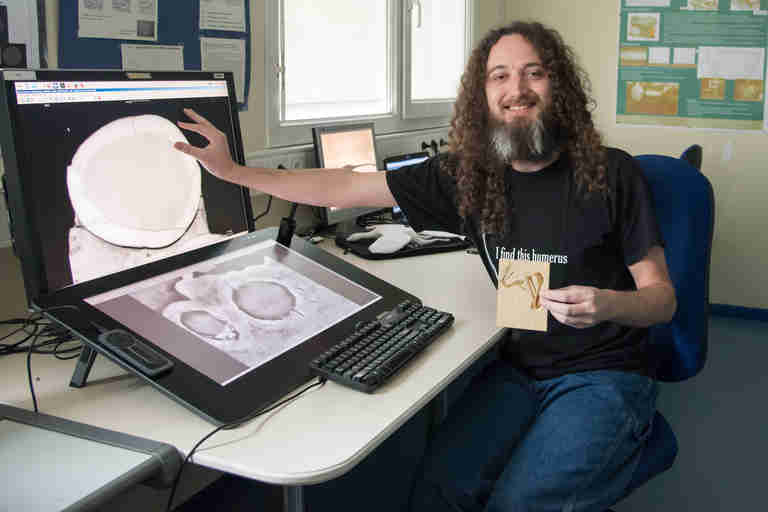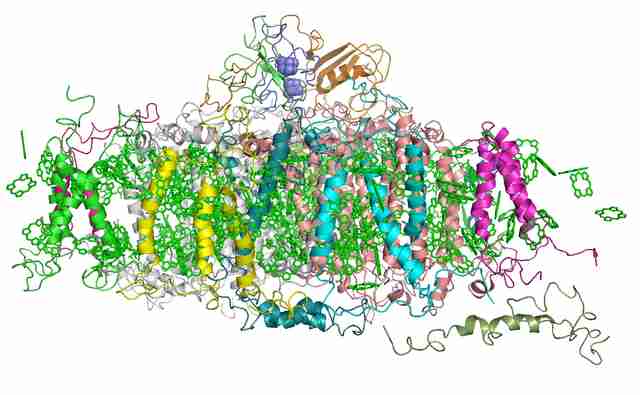 |
| Students excavating the site at Vleesbaai. |
Imagine a year in Africa that summer never arrives. The sky takes on a gray hue during the day and glows red at night. Flowers do not bloom. Trees die in the winter. Large mammals like antelope become thin, starve and provide little fat to the predators (carnivores and human hunters) that depend on them. Then, this same disheartening cycle repeats itself, year after year. This is a picture of life on earth after the eruption of the super-volcano, Mount Toba in Indonesia, about 74,000 years ago. In a paper published this week in Nature, scientists show that early modern humans on the coast of South Africa thrived through this event.
An eruption a hundred times smaller than Mount Toba -- that of Mount Tambora, also in Indonesia, in 1815 -- is thought to have been responsible for a year without summer in 1816. The impact on the human population was dire -- crop failures in Eurasia and North America, famine and mass migrations. The effect of Mount Toba, a super-volcano that dwarfs even the massive Yellowstone eruptions of the deeper past, would have had a much larger, and longer-felt, impact on people around the globe.
The scale of the ash-fall alone attests to the magnitude of the environmental disaster. Huge quantities of aerosols injected high into the atmosphere would have severely diminished sunlight -- with estimates ranging from a 25 to 90 percent reduction in light. Under these conditions, plant die-off is predictable, and there is evidence of significant drying, wildfires and plant community change in East Africa just after the Toba eruption.
If Mount Tambora created such devastation over a full year -- and Tambora was a hiccup compared to Toba -- we can imagine a worldwide catastrophe with the Toba eruption, an event lasting several years and pushing life to the brink of extinctions.
In Indonesia, the source of the destruction would have been evident to terrified witnesses -- just before they died. However, as a family of hunter-gatherers in Africa 74,000 years ago, you would have had no clue as to the reason for the sudden and devastating change in the weather. Famine sets in and the very young and old die. Your social groups are devastated, and your society is on the brink of collapse.
The effect of the Toba eruption would have certainly impacted some ecosystems more than others, possibly creating areas -- called refugia -- in which some human groups did better than others throughout the event. Whether or not your group lived in such a refuge would have largely depended on the type of resources available. Coastal resources, like shellfish, are highly nutritious and less susceptible to the eruption than the plants and animals of inland areas.
When the column of fire, smoke and debris blasted out the top of Mount Toba, it spewed rock, gas and tiny microscopic pieces (cryptotephra) of glass that, under a microscope, have a characteristic hook shape produced when the glass fractures across a bubble. Pumped into the atmosphere, these invisible fragments spread across the world.
Panagiotis (Takis) Karkanas, director of the Malcolm H. Wiener Laboratory for Archaeological Science, American School of Classical Studies, Greece, saw a single shard of this explosion under a microscope in a slice of archaeological sediment encased in resin.
"It was one shard particle out of millions of other mineral particles that I was investigating. But it was there, and it couldn't be anything else," says Karkanas.
The shard came from an archaeological site in a rockshelter called Pinnacle Point 5-6, on the south coast of South Africa near the town of Mossel Bay. The sediments dated to about 74,000 years ago.
"Takis and I had discussed the potential of finding the Toba shards in the sediments of our archaeological site, and with his eagle eye, he found one," explains Curtis W. Marean, project director of the Pinnacle Point excavations. Marean is the associate director of the Institute of Human Origins at Arizona State University and honorary professor at the Centre for Coastal Palaeoscience at Nelson Mandela University, South Africa.
Marean showed the shard image to Eugene Smith, a volcanologist with the University of Nevada at Las Vegas, and Smith confirmed it was a volcanic shard.
"The Pinnacle Point study brought me back to the study of glass shards from my master's thesis 40 years earlier," says Smith.
Early in the study, the team brought in expert cryptotephra scientist Christine Lane who trained graduate student Amber Ciravolo in the needed techniques. Racheal Johnsen later joined Ciravalo as lab manager and developed new techniques.
From scratch, with National Science Foundation support, they developed the Cryptotephra Laboratory for Archaeological and Geological Research, which is now involved in projects not only in Africa, but in Italy, Nevada and Utah.
Encased in that shard of volcanic glass is a distinct chemical signature, a fingerprint that scientists can use to trace to the killer eruption. In their paper in Nature, the team describes finding these shards in two archaeological sites in coastal South Africa, tracing those shards to Toba through chemical fingerprinting and documenting a continuous human occupation across the volcanic event.
"Many previous studies have tried to test the hypothesis that Toba devastated human populations," Marean notes. "But they have failed because they have been unable to present definitive evidence linking a human occupation to the exact moment of the event."
Most studies have looked at whether or not Toba caused environmental change. It did, but such studies lack the archaeological data needed to show how Toba affected humans.
The Pinnacle Point team has been at the forefront of development and application of highly advanced archaeological techniques. They measure everything on site to millimetric accuracy with a "total station," a laser-measurement device integrated to handheld computers for precise and error-free recording.
Naomi Cleghorn with the University of Texas at Arlington, recorded the Pinnacle Point samples as they were removed.
Cleghorn explains, "We collected a long column of samples -- digging out a small amount of sediment from the wall of our previous excavation. Each time we collected a sample, we shot its position with the total station. We could then precisely compare the position of the sample to our excavated cultural remains -- the trash ancient humans left at the site. We could also compare our cryptotephra sample position with that of samples taken for dating and environmental analyses."
In addition to understanding how Toba affected humans in this region, the study has other important implications for archaeological dating techniques. Archaeological dates at these age ranges are imprecise -- 10 percent (or 1000s of years) error is typical. Toba ash-fall, however, was a very quick event that has been precisely dated. The time of shard deposition was likely about two weeks in duration -- instantaneous in geological terms.
"We found the shards at two sites," explains Marean. "The Pinnacle Point rockshelter (where people lived, ate, worked and slept) and an open air site about 10 kilometers away called Vleesbaai. This latter site is where a group of people, possibly members of the same group as those at Pinnacle Point, sat in a small circle and made stone tools. Finding the shards at both sites allows us to link these two records at almost the same moment in time."
Not only that, but the shard location allows the scientists to provide an independent test of the age of the site estimated by other techniques. People lived at the Pinnacle Point 5-6 site from 90,000 to 50,000 years ago. Zenobia Jacobs with the University of Wollongong, Australia, used optically stimulated luminescence (OSL) to date 90 samples and develop a model of the age of all the layers. OSL dates the last time individual sand grains were exposed to light.
"There has been some debate over the accuracy of OSL dating, but Jacobs' age model dated the layers where we found the Toba shards to about 74,000 years ago -- right on the money," says Marean. This lends very strong support to Jacobs' cutting-edge approach to OSL dating, which she has applied to sites across southern Africa and the world.
"OSL dating is the workhorse method for construction of timelines for a large part of our own history. Testing whether the clock ticks at the correct rate is important. So getting this degree of confirmation is pleasing," says Jacobs.
In the 1990s, scientists began arguing that this eruption of Mount Toba, the most powerful in the last two million years, caused a long-lived volcanic winter that may have devastated the ecosystems of the world and caused widespread population crashes, perhaps even a near-extinction event in our own lineage, a so-called bottleneck.
Read more at
Science Daily






















